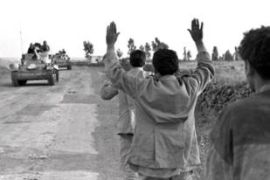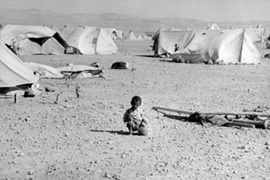1967 Arab-Israeli war timeline
A chronology of the major military events during the conflict.

Within hours the largest and most modern Arab air force is almost wiped out.
Shortly afterwards, the Israeli army crosses into the Sinai peninsula and the Gaza Strip to confront Egyptian units.
| IN DEPTH | |||||||||||
|
Israel sends a message to King Hussein of Jordan through the United Nations, encouraging his forces in the Jordan-controlled West Bank to stay out of the war.
After receiving false reports of Egyptian successes, Jordanian troops move into the Israeli-held west of Jerusalem, seizing control of Government House, a building used as a headquarters by UN observers.
They also begin to bombard Israeli positions in Jerusalem and Tel Aviv.
Meanwhile, a small Syrian force attacks a water plant in northern Israel.
Several Syrian tanks are lost in the early hours and the Syrian command abandon plans for a ground assault, opting instead to shell towns in the Hula valley.
Israel turns its attention to Jordan and Syria’s air forces. By the evening, Jordan’s small air force has largely been destroyed and Syria has lost two-thirds of its aircraft.
June 6
At midnight, Israeli troops move against the Jordanian troops in Jerusalem and by dawn almost encircle the city.
Throughout the day they capture a number of strategic sites held by the Jordanians.
The Latrun police fort on the edge of the West Bank is taken while other soldiers cut the main road between Jerusalem and Ramallah.
 |
| Thousands of Arab soldiers were captured by Israel during the conflict [AP] |
Later in the day, paratroopers take the Jordanian outpost of Ammunition Hill in North Jerusalem after some of the fiercest hand-to-hand fighting of the war.
Meanwhile, in the Gaza Strip, Ramallah and Jenin fall to the Israelis as they complete their capture of the territory.
After destroying the Arab air forces on the first day, Israeli fighters and bombers support the tank and infantry forces on the ground in preventing Jordanian reinforcements reaching their comrades in Jerusalem.
Egypt’s forces begin to fall back in the face of the Israeli advance in the Sinai. By the evening, Egypt orders the general retreat of its army and as they fall back towards the Suez canal the Israelis decide to race to the mountains of western Sinai and destroy them as they cross.
At midnight, the general retreat of the Jordanian Arab Legion is ordered.
June 7
Israeli paratroopers take control of the Western Wall, the remnants of Solomon’s temple and the holiest site in Judaism, amid heavy fighting in the Old City of Jerusalem.
It is the first time the wall is in Jewish hands for more than 2,000 years.
Jordan orders a final general retreat as Israeli forces capture Bethlehem, Hebron and Jericho.
The whole of the West Bank and Jerusalem is annexed by Israel as Jordanian forces are forced back across the river Jordan.
A UN-brokered ceasefire between Israel and Jordan comes into force that evening.
June 8
 |
|
The 1967 war worsened an already dire |
Israeli ground and paratroop forces continue to push the retreating Egyptians back towards the mountain passes of western Sinai, fighting artillery battles with them as they fall back.
The slow-moving convoys of Egyptian troops become trapped in the narrow passes and are decimated by the unopposed Israeli air force.
Israel completes the capture of the Sinai as infantry units reach Ras-Sudar on the western coast of the peninsula.
By the end of the day, Egypt is forced into a ceasefire.
June 9
After delaying its offensive against Syria until it can free up troops from the Egyptian and Jordanian fronts, Israel now moves against the Syrian army in its heavily entrenched positions in the Golan Heights.
Paratroopers defeat a series of posts overlooking the Hula valley in the southern sector of the Heights, enabling the passage of tanks deep into Syrian territory.
Gamal Abdul Nasser resigns as president of Egypt over the defeat.
Mass rallies supporting Nasser follow in Egypt and across the Arab world and he resumes power.
June 10
Israeli units move to trap the Syrians on the Golan plateau, but as the balance of power shifts in Israel’s favour, the Syrians flee.
Early in the afternoon, Israel captures the town of Kuneitra and by the evening an armistice is agreed, leaving Israel in control of all of the Golan Heights, including parts of Mount Hermon.
Israel’s campaign has vastly increased its territory and brought more than one million Palestinians under its control.
